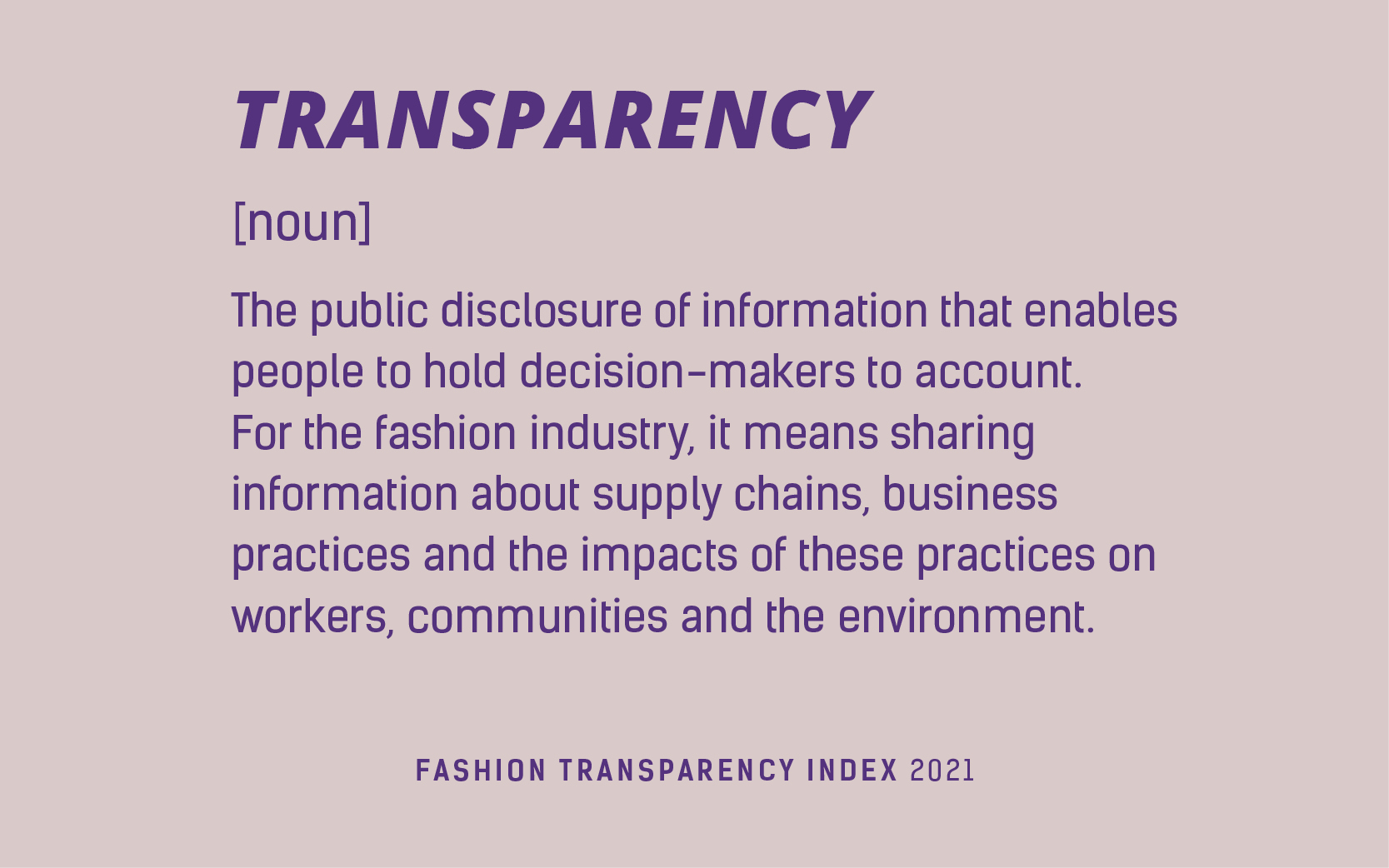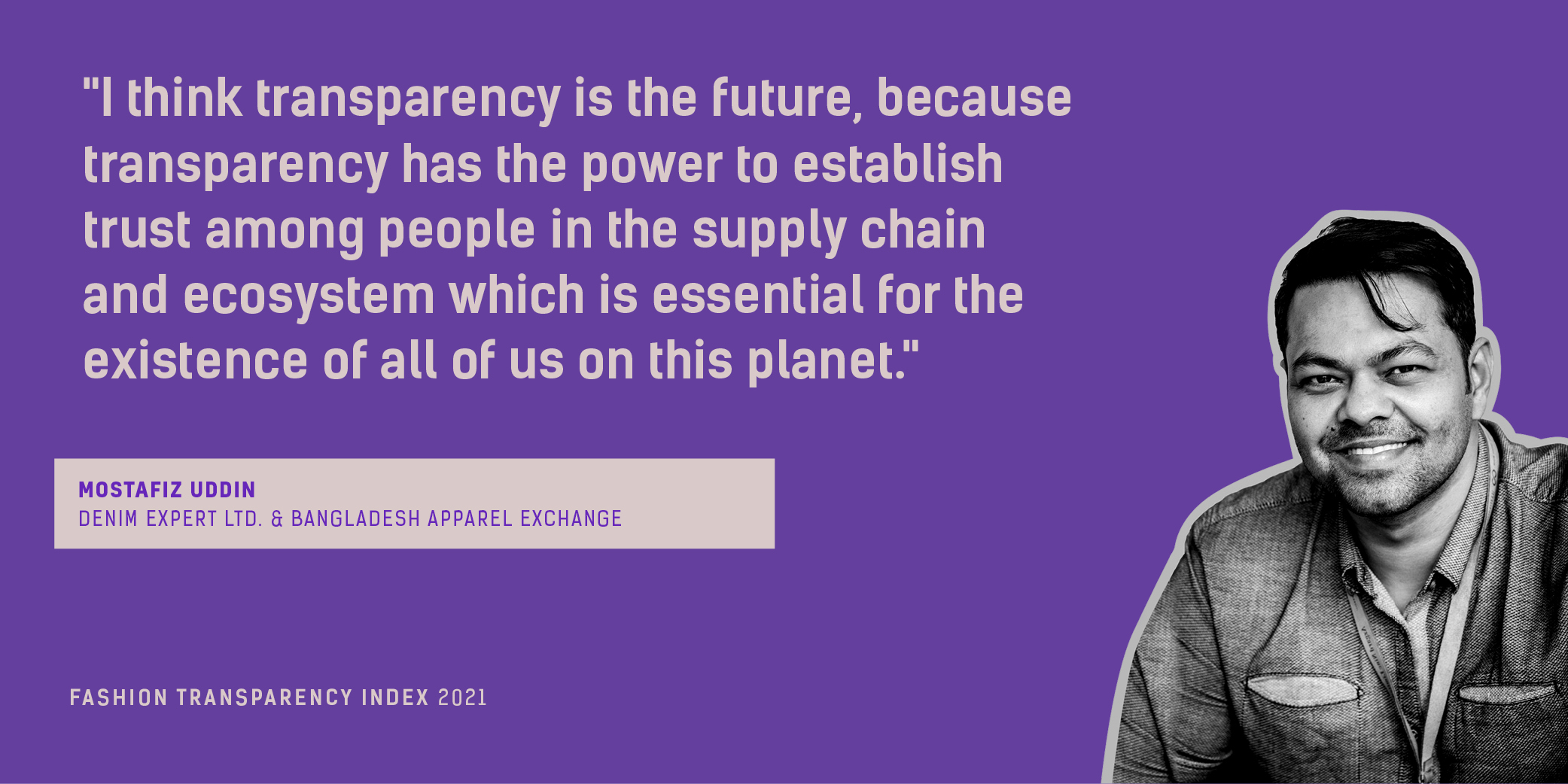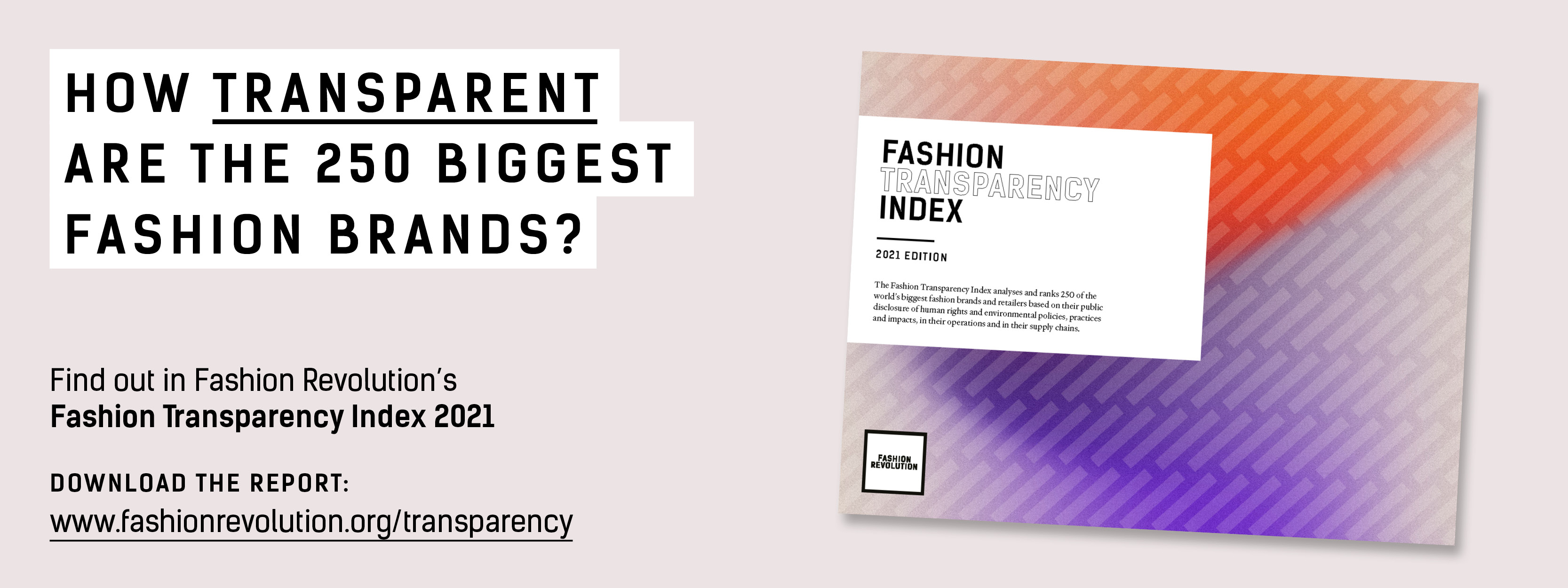Why fashion transparency matters, according to the experts
The 2021 Fashion Transparency Index is here, and it dives deep into the data on transparency across 239 indicators for 250 of the world’s largest fashion brands. We publish the Index every year because we believe that transparency underpins transformative change in the global fashion industry. But what does transparency really mean? And why does it matter in our fight to build a fashion industry that conserves and restores the environment and values people over growth and profit? In this blog post, discover the case for transparency in the global fashion industry from the experts who are working to change it.
View this post on Instagram
Theory of change: The role of transparency
Fashion supply chains are highly globalised, deregulated, complex and opaque. Business relationships are murky, and subcontracting is common. This obscures responsibility and accountability when things go wrong, as they so often do. The lack of transparency means we cannot easily see and take swift and appropriate action on environmental and human rights abuses. Without transparency, we cannot protect vulnerable people and the planet.
Transparency is the public disclosure of information that enables people to hold decision makers to account. For the fashion industry, it means sharing credible, comprehensive and comparable information about supply chains, business practices and the impacts of these practices on workers, communities and the environment. Transparency enables anyone – but especially investors, lawmakers, journalists, NGOs, trade unions, workers and their representatives – to hold brands and retailers to account by:
- Scrutinising what companies say they are doing to address human rights and protect the environment
- Holding brands and retailers accountable for their policies and practices, which is especially important when abuses occur
- Collaborating to cease, mitigate, prevent, remedy and account for environmental and human rights abuses
- Collaborating to share strategies and best practice on these issues
Transparency is a tool for change, not the end goal. Transparency is a baseline, without which we cannot meaningfully move towards accountability and positive impact in the global fashion industry. Transparency is not a silver bullet that will solve all of the complex and deeply systemic problems in the global fashion industry. However, transparency provides a window into the places and conditions in which our clothes are being made and allows us to address them more quickly and collaboratively. Transparency is not to be confused with sustainability, but without transparency, achieving a sustainable, accountable and fair fashion industry will be impossible.
Case studies: Fashion transparency in action

Business & Human Rights Resource Centre (BHRRC)
Amid the ongoing Covid-19 pandemic, a report by Business and Human Rights Resource Centre (BHRRC) analysed global apparel brands’ response to allegations of suppliers’ unfair dismissal of unionised workers, focusing on nine case studies. Research revealed more than 4,870 unionised garment workers were targeted for dismissal in nine garment factories across India, Bangladesh, Myanmar and Cambodia, which supply major fashion brands.
Whilst suppliers cited reduced orders and economic impacts from Covid-19 as a cause for these dismissals, workers reported feeling they were disproportionately targeted because of their union membership and organising efforts and that non-unionised workers had been hired as replacements. In some cases, workers reported having been dismissed after registering new unions or having requested increased protections against Covid-19 at work. Publicly available supplier data-enabled BHHRC to help resolve cases where workers had been unfairly dismissed by identifying and contacting the brands sourcing from these factories.
Read the full case study on page 24 of the Fashion Transparency Index
The Australian Strategic Policy Institute (ASPI)
A report by the Australian Strategic Policy Institute (ASPI) estimates over one million people have been detained in detention camps designed to force minority groups to abandon their cultural traditions, which the Chinese government has characterised as “re-education centres”. Between 2017 and 2019, reports suggest that the state-sponsored labour transfer programme has moved more than an estimated 80,000 Uyghur people out of XUAR to work in factories across China, though this figure is likely much higher. ASPI’s research relied heavily on transparency information such as publicly disclosed supplier lists, which ASPI used to establish that the forced labour of Uyghur people can be linked to 83 major global brands and retailers. ASPI was able to reach out to implicated brands to confirm their supplier details and alert them to their links to allegations of state-sponsored forced labour in the region. ASPI called for brands to conduct immediate and thorough investigations into allegations of forced labour in factories across the region and the country.
Most companies implicated in the report issued a statement in response, with some verifying whether or not they source from facilities implicated in the use of Uyghur forced labour. Some brands committed to stop sourcing cotton from XUAR entirely as a result. Without the public disclosure of supplier lists, it is difficult to prove the links between global brands and their suppliers in order to hold them accountable for their contribution to serious human rights violations.
Read the full case study on page 24 of the Fashion Transparency Index
Zero Discharge of Hazardous Chemicals (ZDHC) & Open Apparel Registry (OAR)
ZDHC is an association of apparel and footwear brands, chemical suppliers and manufacturers working together to reduce the chemical footprint of global textile production by systematically transforming how chemicals are used and establishing tools for sustainable chemical management. ZDHC has partnered with OAR, a neutral and freely available tool that maps and assigns unique identification numbers to garment facilities around the world to help standardise facility names and addresses. Due to the global nature of supply chains and differing languages, various actors may record a facility’s name and address information differently, leading to duplicate, inaccurate and outdated information which makes verifying relationships between brands and their suppliers more complicated. A unique ID helps to change this – kind of like how there could be thousands of people with the name John Smith in the world, but a social security number or national insurance number helps the government differentiate between them.
Linking ZDHC and OAR’s databases has enabled communication between two previously siloed platforms, helping to reduce duplication and increasing the accuracy of the links between global brands and their suppliers. This is important because it helps stakeholders like environmental groups and government agencies to identify a facility, address chemical use and pollution and work together to improve wastewater treatment where it’s most needed.
Read the full case study on page 25 of the Fashion Transparency Index
Advocating Rights in South Asia (Arisa) & the Centre for Research on Multinational Corporations (SOMO)
Arisa has carried out research into working conditions in Tamil Nadu for many years. Tamil Nadu is a state in the southern part of India where over 60% of all Indian spinning mills are located and where 280,000 workers are employed. Between 2019 and 2020, Arisa worked with SOMO, a not-for-profit organisation that investigates the impact of multinational corporations’ activities on people and the environment. The purpose of the research was to help enable structural improvements to employment, working and living conditions in Tamil Nadu’s textile industry, particularly for the most vulnerable worker groups; primarily child, adolescent, female and migrant workers as well as workers with tribal, ethnic or low-caste backgrounds, including Dalits. Arisa and SOMO used publicly available production location lists via Open Apparel Registry and the Panjiva database to establish links between Tamil Nadu spinning mills and 10 multinational apparel brands.
Research was carried out across 29 spinning mills and 725 workers were interviewed. Indicators of forced labour were identified across all 29 spinning mills, including: abuse of vulnerability, deception, intimidation and threats, abusive working and living conditions, and excessive overtime. Two of the implicated brands came forward and asked the research team to help them get in contact with other brands sourcing from a particular mill, which was possible to prove through publicly disclosed information. This led to three brands working together to address the allegations raised.
Read the full case study on page 25 of the Fashion Transparency Index
Viewpoints: Why transparency matters

TRANSPARENCY ON ENVIRONMENTAL, SOCIAL AND GOVERNANCE ISSUES AND THE ROLE OF INVESTORS
ELINE SLEURINK, HEAD, UK & IRELAND AND HEAD, NETHERLANDS AT PRINCIPLES FOR RESPONSIBLE INVESTMENT (PRI)
“Investors rely on company performance data to measure ESG. We need mandatory and comparable ESG disclosure to support this. The growth of the fashion industry has led to an explosion of cross-border supply chains with increasing levels of opacity. This has led to associated challenges for investors as they try to ascertain any negative environmental and social impacts a company has, yet often lack the appropriate data. Upcoming legislation in the EU will require companies to be more transparent and provide these impact disclosures, enabling an environment where we have a unified approach to preventing and remedying violations caused by business practices. This is a valuable step towards ensuring that we can identify and remediate any negative social and environmental impacts a fashion brand might be responsible for.”
Read the full article on page 56 of the Fashion Transparency Index
A LACK OF TRANSPARENCY AND THE UYGHUR CRISIS
DR FLAVIA LOSCIALPO, SENIOR RESEARCH FELLOW IN CULTURAL STUDIES AND FASHION AT SOLENT UNIVERSITY;
ELEONORA MONGELLI, VICE PRESIDENT OF THE ITALIAN FEDERATION FOR HUMAN RIGHTS;
DOLKUN ISA PRESIDENT, WORLD UYGHUR CONGRESS
“Not only is transparency paramount to conscious purchasing practices, but it is the very foundation of accountability in terms of human rights and environmental issues. Uyghur forced labour is an example of the atrocities that can occur when companies are not able to verify what happens in their supply chains, and when they are not legally obliged to disclose information about their suppliers. Human rights cannot be an option for companies. Businesses have a significant impact on human rights wherever they operate. This impact can be positive or negative. It is up to us to choose.”
Read the full article on page 73 of the Fashion Transparency Index
HOW MAJOR APPAREL BRANDS RESPONDED TO THE COVID-19 PANDEMIC
MARK ANNER, DIRECTOR OF THE CENTER FOR GLOBAL WORKERS’ RIGHTS AT THE PENNSYLVANIA STATE UNIVERSITY
“[In the Fashion Transparency Index] Only 3% of brands were willing to adequately answer a question related to workers receiving wage payments during the pandemic, and only 3% responded to a question about worker layoffs. What we know is that more than 3 million garment workers lost their jobs during the pandemic, and many were denied millions in back wages and severance. These trends indicate it is not enough to ensure that brands properly pay suppliers, but that there also must be mechanisms in place to ensure payment of wages, protection of jobs, and guarantees for worker safety and social protection. The best mechanisms to do that are strong, independent unions with collective bargaining rights; enforceable, binding agreements; and robust social safety nets. It is precisely these mechanisms that must be an integral part of ‘building back better’.”
Read the full article on page 81 of the Fashion Transparency Index
A MANUFACTURER’S PERSPECTIVE ON THE NEED FOR MORE TRANSPARENCY IN THE GLOBAL FASHION INDUSTRY
MOSTAFIZ UDDIN, MANAGING DIRECTOR OF DENIM EXPERT LTD, CLOTHING MANUFACTURER IN BANGLADESH
“Until the time transparency is treated as a mechanism to hold manufacturers and brands accountable, we will be unlikely to find ourselves in a situation conducive to achieving the Sustainable Development Goals. There has to be more equilibrium in the power dynamics between brands and suppliers. Undue dominance and exercise of power need to end. Indeed, the main reasons why brands and retailers can continue with unfair and unethical purchasing practices with impunity is because there is a lack of transparency on their part. Manufacturers do not raise their voice against such irresponsible purchasing behaviours for fear of reprisals from brands. Transparency can be critical to create a level playing field for manufacturers across the globe.”
Read the full article on page 83 of the Fashion Transparency Index
WHY A LACK OF TRANSPARENCY COSTS LIVES FOR GARMENT WORKERS
NAZMA AKTER, EXECUTIVE DIRECTOR AT AWAJ FOUNDATION; PRESIDENT OF SOMMILITO GARMENTS SRAMIK FEDERATION IN BANGLADESH
“We workers want profit share. Because we made your clothes, we make you profit, we make you rich, we make you famous…but we have nothing. Profit share is important. Collective bargaining is also very important. Women should lead and also share in opportunities, like increasing salary bonuses. Women should be empowered and treated with dignity and respect. Maternity leave should be ensured. Women have to get proper rest and shouldn’t have to engage in hazardous work. Buyers need to disclose what is going on. How many factory workers, what kind of facilities are there? Do they have a union? There are all kinds of things that should be disclosed on factory lists.”
Read the full article on page 87 of the Fashion Transparency Index
OVERPRODUCTION, CIRCULARITY AND THE SECOND-HAND CLOTHING TRADE
LIZ RICKETTS, CO-FOUNDER AND DIRECTOR OF THE OR FOUNDATION
“Every company in the world knows how many products it manufactures, so there is really no excuse for not disclosing this information. It speaks volumes to the fact that brands are afraid this will reveal their true impact on the planet and undermine the greenwashing claims that are made in their marketing campaigns. Publishing data on the number of items would also force brands to confront the fact that supply and demand is not as straightforward as they claim. Brands intentionally overproduce because they cannot predict what people will buy and yet these same brands often claim that they only produce based on demand. This myth that supply and demand are neutral forces has been carried forward into the second-hand trade with brands suggesting that they only export what people in the Global South demand. If this were true then 40% of the clothing that flows through Kantamanto market in Ghana, where my work is based, would not go to waste. Disclosing production volumes would not only allow for more honest dialogue, but it would lead to more meaningful innovation across the value chain.”
Read the full article on page 92 of the Fashion Transparency Index
WHY MORE TRANSPARENCY ON THE USE OF HAZARDOUS CHEMICALS IN CLOTHING IS ESSENTIAL
VIOLA WOHLGEMUTH, CONSUMPTION AND TOXICS CAMPAIGNER AT GREENPEACE GERMANY
“Reports of progress need to be verified by the publication of data on the discharge of hazardous chemicals into wastewater – at the moment only 36 brands (14%) say they are reporting their suppliers’ wastewater data. This lack of transparency prevents local communities, public interest groups and consumers from finding out where hazardous chemicals are being discharged and what progress has been made to eliminate this problem. Also of concern is that not many brands publish water footprint reports for suppliers and fibre production, despite the high number of brands with a policy on this. Action on the environmental impacts at supply chain facilities needs to be holistic – starting with thorough chemical management and applying this approach to water and resource consumption, atmospheric emissions, energy consumption, and the release of greenhouse gases.”
Read the full article on page 95 of the Fashion Transparency Index
TRANSPARENCY ON CARBON FOOTPRINTS IS KEY TO CREDIBILITY OF BRANDS’ SCIENCE-BASED TARGETS
PAULINE OP DE BEECK, EU BUSINESS DEVELOPMENT MANAGER AND SUSTAINABLE FASHION LEAD FOR THE CARBON TRUST
“Once an organisation has set targets, being transparent about the underlying boundaries, assumptions and emissions profile that constitutes them is crucial in order to understand if they are indeed aligned with the requirements of the Paris Agreement and the Science-Based Targets initiative. Transparency on carbon is essential because we want to be able to understand how these targets truly reflect a company’s impact and the specific challenges that a company will be addressing. Improved accuracy and transparency on carbon footprints is key to the credibility of any organisation’s science-based targets and/or net-zero commitments.”
Read the full article on page 99 of the Fashion Transparency Index

Further reading
Find out more about transparency in the fashion industry and read the 2021 Fashion Transparency Index.
Read the Global call for full supply chain transparency in the clothing sector, signed by 30 leading NGOs:
A global call for full supply chain transparency in the clothing sector








